As you may or may not know, November is Solo Gaming Appreciation Month! Or, SGAM, as it’s often and lovingly referred to, it’s an entire month dedicated to the teaching, sharing, and enjoyment of solo– erm? What’s that you say? Yes, it is currently December. (*frown*) Yes, I do realize I’ve missed it. Uh huh. Right… Well, I don’t care, it’s my blog and technically I did play solo in the month of November… I’m just now getting around to sharing it! So what! *storms out of the room and slams the door*
Just kidding, I came back.
So, How’s About a Review?
Thus far, I’ve been hesitant to call any of my posts a “review”. In general, I’m still new to soloing, and, really, new-again to tabletop RPGs. I’ve not read “the three booklets” or played any retroclones. I’ve obtained quite a collection of PDFs and a few print books (or printed and bound my own from the PDFs) in a short time, but have read only a handful of them, and actually played fewer still.
Playing and critiquing a game from the position of a player or a GM isn’t really an option to me outside of playing with my wife & kids, so outside of the solo aspect — which, granted, is a little bit of player and a little bit of GM, but not quite the same social game — I don’t have any experiential ground to stand on for typical review type stuff like commenting on how a certain aspect of a game compares or improves upon the ideas set forth by this other game, and things of that nature.
Given all that, I still have a tendency to critically analyze things while I’m reading them, so I often feel pulled to share such thoughts with others — whether you want to hear them or not! Muwahahaha!
Just kidding. Again.
Anyways, this Four Against Darkness game had been on my solo radar for quite some time, and I decided I wanted to give it a try. As it turns out, while it reeks of RPG, it’s more or less considered a board game designed for one player. I saw an opening here, since this isn’t your typical pen & paper RPG (even if it’s first cousins), to interject my opinion of it without having to assuage too much guilt for not being an old-timey “grognard” who’s played all the RPGs from the dawn of time and knows what’s what about everything.
I suppose, though, we wouldn’t have quite the incredible landscape of RPGs and RPG bloggers that we have now, if everyone — even the n00bs — didn’t share their thoughts and experiences. After all, even advanced yogis aspire to the “beginner’s mindset” — open, eager, and free of preconceptions.
Four Against Darkness
“A solitaire dungeon-delving game,” Four Against Darkness is quite enjoyable, for beginners and grognards, alike. Written by Andrea Sfiligoi and published by Ganesha Games, it combines a simple set of “RPG” mechanics with rules and tables for generating and populating a dungeon as you move your party of four adventurers from room to randomly-shaped, hand-drawn room. All you need is some graph paper, a pencil, and a sturdy eraser (you’ll be doing a lot of erasing). Oh, and dice — at least one six-sider, though 2 or 3 will be more convenient (especially if one is a different color or style).
It’s fun as heck, once you get going, which may take you a while. I found the book to be laid out a bit haphazardly, or at least I couldn’t find the rhyme or reason to it. It starts off well enough, giving you an intro about its old-school, dungeon-crawling inspirations, a general overview of some of the concepts, and then covers the 8 player classes — which does include the dwarf, halfling, and elf race-as-class options you may or may not appreciate. Warrior, cleric, rogue, wizard, and barbarian round out the rest (sold-separately adventure modules add Swashbuckler and Paladin into the mix as well). It then flows somewhat logically into buying and selling equipment.
From there, things got muddled for me. After equipment, there’s some explanations of how to attack monsters, then an infodump of about 15 pages full of the random charts you’ll need to draw the dungeon and run the game, and continues downhill from there. As I said, I found it a bit haphazard, and until I managed to store it all up in the ol’ noggin, I did quite a bit of page flipping trying to find spell descriptions, tables for searching and wandering monsters, etc., until I finally just annotated the “appendix” at the end of the book to my liking. There are repeated all the random charts alongside character and play sheets, a very useful flow-chart, and could-be-useful-to-you “shorthand symbols” for labeling your room contents on the map (I started out using these, but later found it easier and cleaner to just number each room and write the contents, etc. elsewhere).
That was my only real complaint about 4AD — not the game itself, but illogical sequencing of the rules. The rest of the book layout is fine, but with a mixed bag of (mostly high quality) old-school ink illustrations, pencil drawings, and several renderings, if that sort of thing matters to you. The PDF does contain bookmarks, which I know a lot of folks out there appreciate (myself included).
Gameplay
For my first play, I started out with my pad of graph paper, and the much-appreciated pocketmods that are included with the download and immediately decided I could cram the recommended 20×28 grid onto a single page with 4 minimal character sheets and still have room to track encounters and such. This evolved into my 4AD Game Board, which you can grab here for free, or (awaiting approval) PWYW on DriveThruRPG if you really appreciate it.
Unfortunately, Darkness won out against my intial Four. After generating my party of Barbarian, Cleric, Wizard, and Rogue, and then rolling for my room, right away the first room contents roll produced a “boss” monster! It was a medusa, so I decided to roll on her reaction chart rather than risk surely being turned to stone. Luckily, she gave me a quest instead of giving me the evil [snake] eye: slay every monster in the dungeon. Well, sure enough I was sold on that — laying waste to the place is exactly what I stepped foot in here to do, anyways, and completing a quest gives some of the best rewards. No brainer.
Continuing on, the following room held a dragon! I was taken aback, of course, to have encountered a boss and then a dragon in my first two consecutive rooms, but I suppose that is the nature of random generation — sometimes the dice give you more than you can handle. I decided to test how tough dragons actually are, which turned out to be a poor decision. It wasn’t long before my party of level 1 imbeciles characters were retreating from the room with the dragon nipping at their heels.
Combat
The combat mechanics are pretty simple. PCs go first, unless surprised by wandering monsters, or mentioned explicitly in the monster description. Attacks and spell-casting are a d6 roll + modifiers, which can be anything from the character’s level, depending on class, to a bonus or penalty from the type of weapon.
Rather than rolling for the monsters’ attacks, you instead make defense rolls for your characters, trying to roll over the monster’s level — again, d6 + modifiers from armor, shield, etc. Some classes get bonuses against certain types of monsters, too. For example, a dwarf outfitted with heavy armor gets a +2 to defense rolls. If he’s defending against a troll, ogre, or giant, he gets another +1. Attacking, he normally adds his level, and gets an additional +1 if attacking goblins.
There’s not really any damage rolls: players and bosses have multiple hitpoints, while “minions” and “vermin”, which come in groups, have a single hitpoint each — and excessive rolls spill over into additional hits. E.g., attacking a group of 3 level 3 minions, and I roll a 7, that actually takes out 2 minions (matching level 3 twice), with an extra point going to waste. The same applies to bosses, shaving off additional life points. Thus, the “explosive six” rule — if you roll a 6, roll again, accumulating ad infinitum — can be particularly devastating to your foes!
Many monsters check morale, also, which can save you the trouble of clearing out “trash” encounters once you’ve made your point. Or, save your party’s behind when the going gets tough.
That initial misstep with the dragon doomed the rest of the adventure since I expended most of my resources (hitpoints and heals) testing out the dragon before I realized it was foolhardy. Not ones to be dissuaded from treasure, my characters pressed on, back through the Medusa room and into a corridor, which thankfully proved empty. I tested fate again by searching the empty room, which could have brought on a surprise attack from wandering monsters, but it was just that: empty.
The rogue, leading the party (which is useful for giving you the chance to disarm traps), opened the door at the end of the corridor and quickly slammed it shut. Another dragon! They chose a different route.
A few corridors later, the rogue failed to disarm a trap, which resulted in the untimely death of the magic user, who went out in a bloody display of mechanical spear thrusts. Things seemed to take an upturn after that, which the Barbarian attributed to being rid of the accursed wizard. They soon came upon a healing altar and renewed their vigor for coming out of this place ahead.
It didn’t last long, though, as they soon stumbled upon a cursed altar — in all things, balance. This proved to be the final ill omen for the group and, by and by, they came upon another Medusa (or perhaps the same one and their initial quest was a vile trick!). The barbarian was struck down. The cleric and rogue, turned to stone.
And they were never seen again. *gasp!*
Round 2
The gods were not entirely cruel, as my second adventure went rather swimmingly. This time I rolled up a Dwarf, Cleric, Elf, and Rogue, fitted them out, and just for fun, generated a random adventure title: The Relentless Palace. It didn’t quite live up to its name, unless you count the unrelenting nature of the party and the smash-and-grab number they did on the joint.
My take-away from this one is that dwarves and elves are way better than barbarians and wizards. Or maybe I just had better rolls. In any case, the party zipped through this one like they were five levels too high for it all. Even spanked the lone dragon they encountered (who, in all fairness, was asleep).
Interestingly enough, the last room I generated contained a statue. Upon further inspection, it became animated and turned out to be the final boss of the adventure. Now, where have I heard that before?
No quests or fancy loot, other than a Wand of Sleep and Lighting spell scroll, but the half the party made it up to level 3 and came home with pockets full of gems and gold. Of course, already itching to go on their next adventure.
Advancement
Leveling up occurs one character at a time, after defeating a boss, completing a quest, collecting clues, or surviving 10 minion encounters. You’ll get an extra point of life, and an additional spell memorization if you’re a magic user. Levels cap at 5, unless you’ve purchased the Four Against the Abyss expansion, which will take you up through level 9.
Most monsters drop gold, gems, or treasure, and slaying bosses or “weird” monsters will get you even greater rewards. Collecting 3 clues allows your choice of several powerful boons, and completing quests affords a roll on the epic rewards table.
Recommendation
I’ve had a lot of fun with Four Against Darkness and enjoyed drumming up the 4AD Game Board supplement to go along with it (check it out, and I hope you find it useful). I wasn’t thrilled with the layout of the book, but the rules aren’t so convoluted you can’t hold the majority of them in your head, so after a few games, you may not need to reference them anymore outside of the tables in the back.
From all accounts, you can get about 15-20 adventures out of the core rule book before you start to tire of repetition. That could be several parties or quite a campaign, and likely months of entertainment, depending how often you play. In my mind, that’s totally worth the entry fee.
Outside of the organization, if anything could be improved upon, it would be upgrading the d6 charts to d66, but then it would be harder to sell you the add-on modules! I’ve not tried any of those yet, but I do plan to check at least one or two of them out. And, as I mentioned, you can expand to Swashbuckler or Paladin with the proper adventure module. Fiendish Foes is specifically a monster chart expansion for level 3+ characters, while others are published adventures which come with their own charts and tables (some with pre-generated maps).
There’s also a Four Against the Abyss expansion that will take you from level 5 through 9, upgrading you to d8 dice rolls, more complex rules, and expanded charts for more random goodness. If you get this deep in, there’s also a Treasure Hunters of Charlemagne adventure module for those higher levels, which sounds like a bit of a romp through historical fiction.
For me, this was a great bang for the buck. Sure, you could take these same premises and create, borrow, or steal the charts you’d need to recreate the same experience in the game of your choice. It’s not really an original concept — heck, Gary Gygax explained how to do it in 1975 in the first issue of The Strategic Review. What 4AD does, though, is simplify things, consolidate it down to just d6 rolls, and package it all up in the same box, which is no small feat.
I would even posit that this game would be a great introduction to RPGs, or at least solo play, for beginners. In fact, I’ve purchased print copies to give as gifts to some unsuspecting (but clearly vulnerable) pals of mine.
It makes for a great all-in-one solution for getting in your solo, dungeon-delving fix, with a bit of old-school flair, folded up and stuffed into your back pocket. You can play for a half hour on your lunch break, or pull out a full sheet of graph paper and crawl along for a couple of hours. String those adventures together into a campaign, and you might even use the system as a building block into a larger system, adding in more narrative and descriptive elements, and drumming up some rules for wilderness excursions to turn it into a more robust soloing game.
If you’re new to soloing, just getting started in RPGs (or perhaps coming for a console/computer RPG background), or haven’t tried a little bit of crunchy dungeon bashing before, I definitely recommend you grab up Four Against Darkness right away.
Totally arbitrary ratings below.
Ol' Fashion' Dungeon Bashin' in Your Back Pocket!
Summary : "A solitaire dungeon-delving game," Four Against Darkness is quite enjoyable, for beginners and grognards, alike. Written by Andrea Sfiligoi and published by Ganesha Games, it combines a simple set of "RPG" mechanics with rules and tables for generating and populating a dungeon as you move your party of four adventurers from room to randomly-shaped, hand-drawn room. All you need is some graph paper, a pencil, and a sturdy eraser
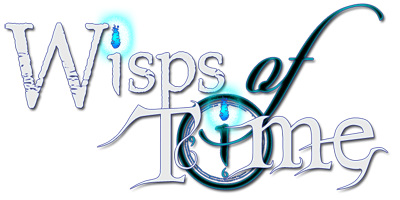
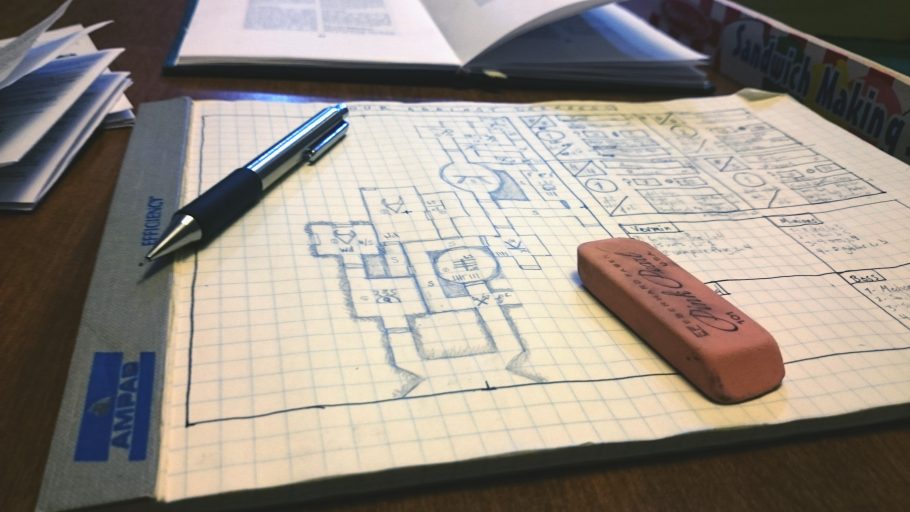
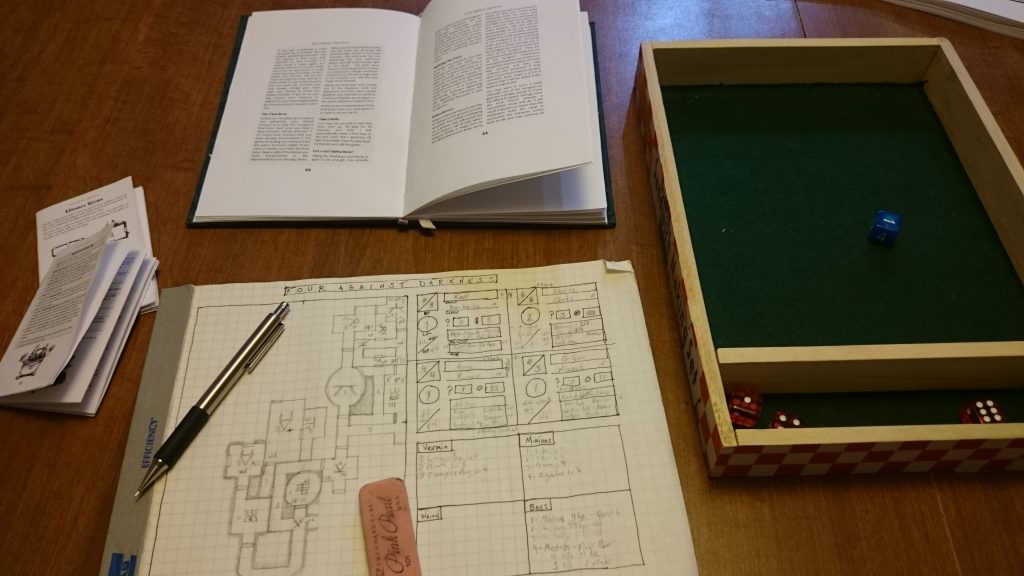
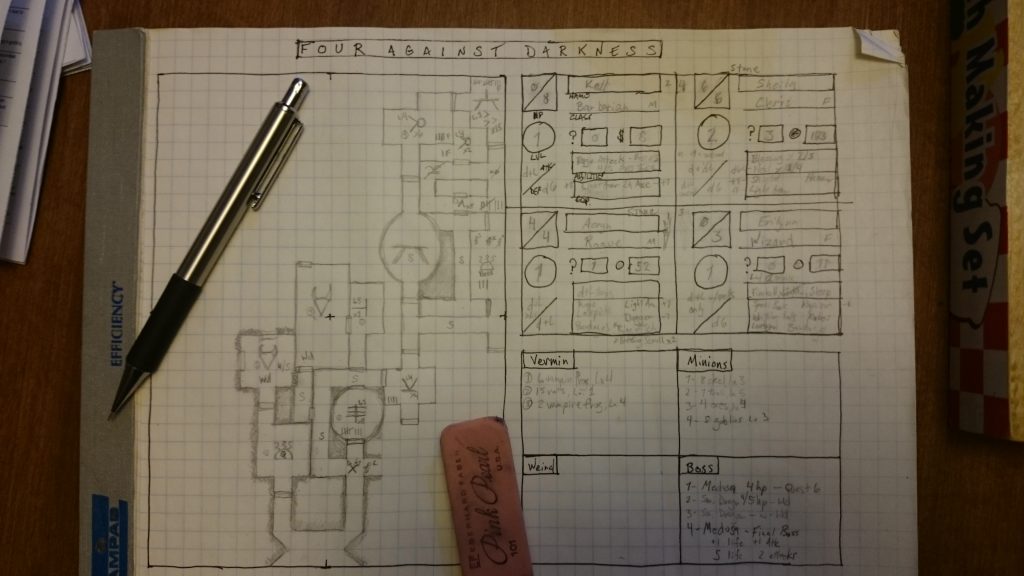
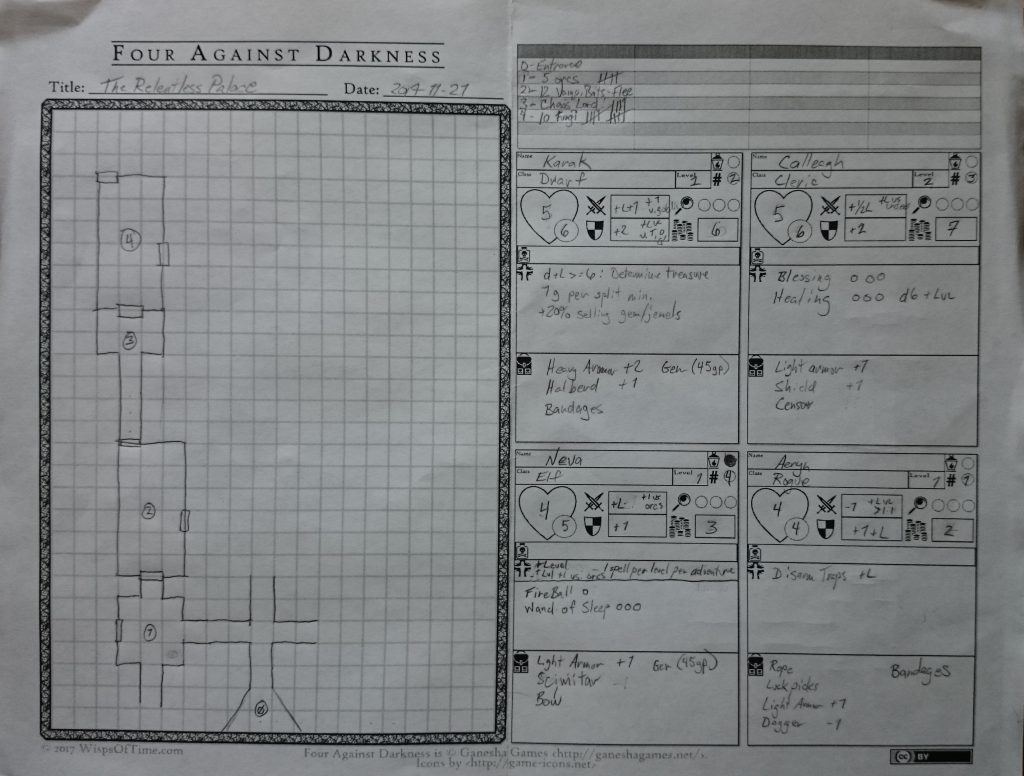
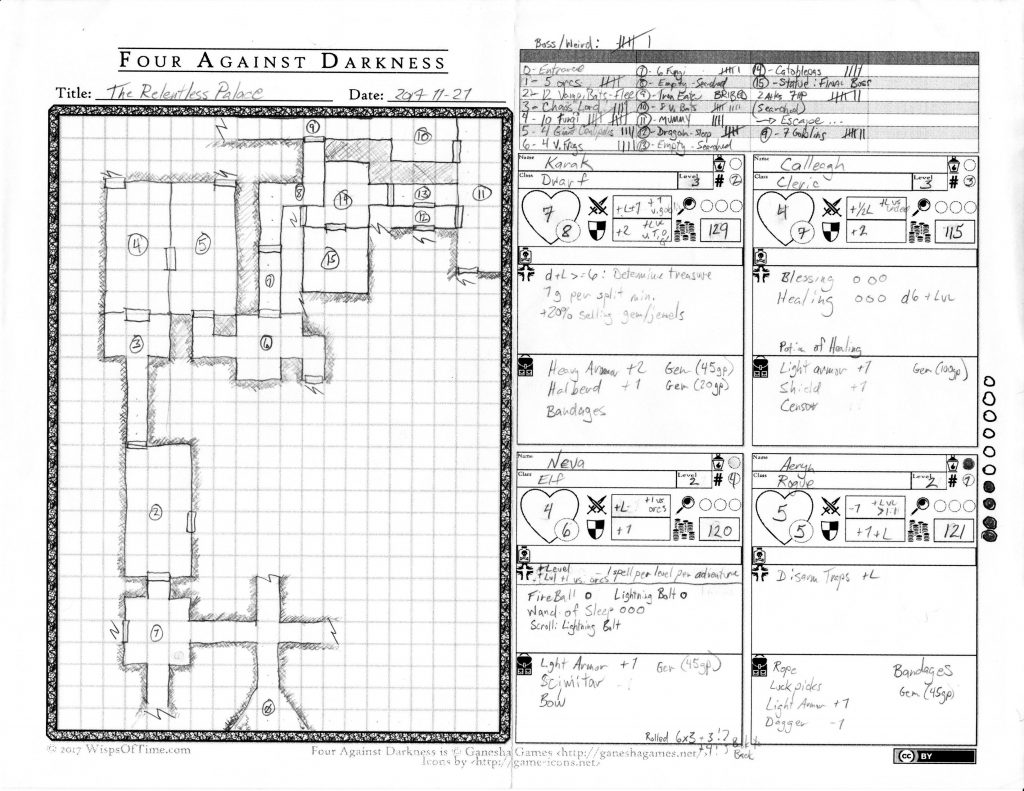
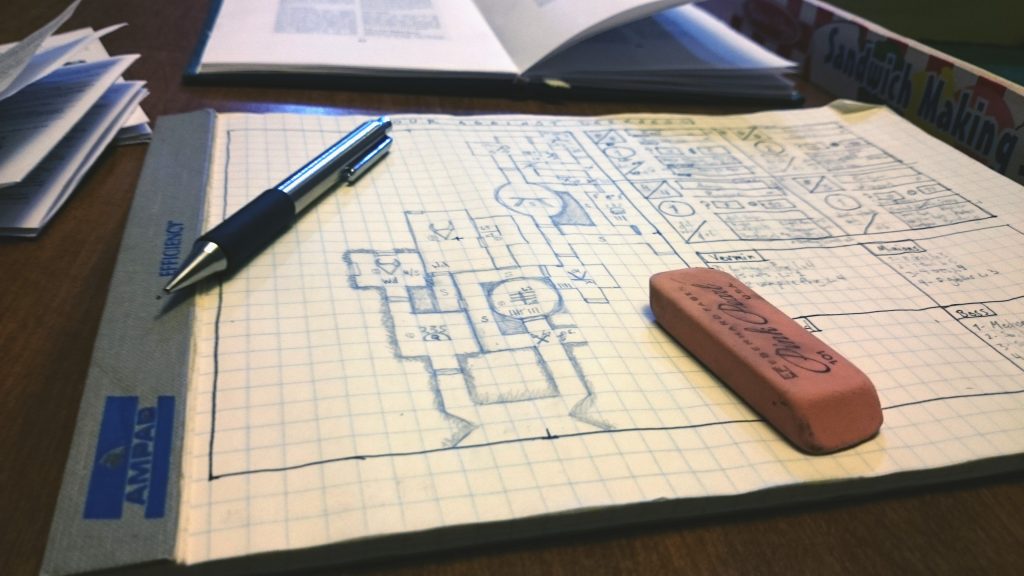




Comments are closed.